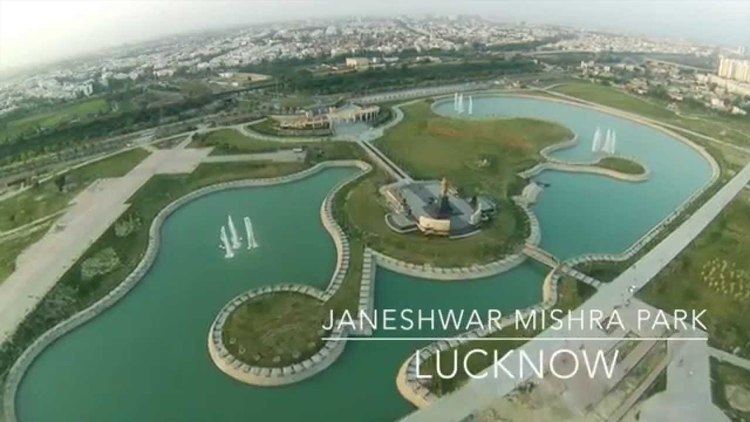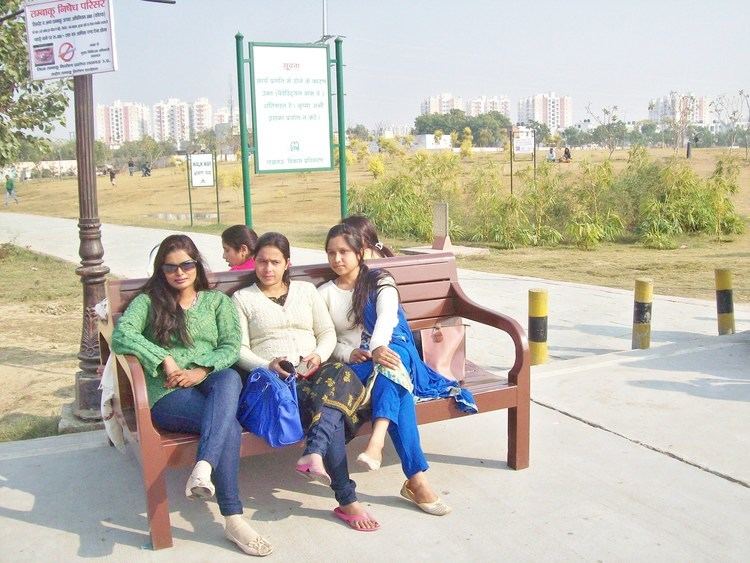Type Public park Created 2014 (2014) | Area 376 acres (1.52 km) Status Open year round | |
Location Gomti Nagar in Lucknow, Uttar Pradesh, India Operated by Lucknow Development Authority Operator Lucknow Development Authority Similar Ambedkar Memorial Park, Dr Ram Manohar Lohia Par, Dilkusha Kothi, Bara Imambara, Anandi Water Park | ||
Janeshwar Mishra Park is an urban park operating in Gomti Nagar in Lucknow, India.
Contents
- History
- Background
- Area characteristics
- Accessibility
- Water bodieswaterwaysfountains
- Park circulation
- Cycle tracks
- Jogging track
- Park lighting
- Signage and furniture
- Public amenities
- Entry plazas
- Statue design
- Childrens play areas
- Parking and circulation
- Plants
- Trees
- Palms
- Tall shrubs
- Medium shrubs
- Ground cover
- Climberscreepers
- Hedges
- Topiary
- Bamboos
- Features
- References
It was made in memory of late politician Janeshwar Mishra from Samajwadi Party.The park was inaugurated for general public of the city on 5 August 2014. It is claimed to be Asia's largest garden.

History

The chief minister of Uttar Pradesh, Akhilesh Yadav (session 2012-2017) laid the foundation stone of the park on 6 August 2012. The park was a dream project of SP chief Mulayam Singh Yadav who had asked his son and UP CM Akhilesh Yadav to dedicate a park in the name of Janeshwar Mishra. It was developed with a cost of 168 crores($276,026,668). The park was modeled with Hyde Park in London as an inspiration.
Background
Lucknow Development Authority (LDA) has developed eco-friendly Janeshwar Mishra Park (JMP) in the heart of the city. It has been conceptualised and designed as a multi-functional environmental and recreational green which will not just provide sustainable habitat for various species of birds but also double up as a major entertainment and recreation centre for all sections of the society. It will enhance and improve the ecological balance and help restore sensitive habitat for numerous species of birds, small animals, fishes, amphibians and even insects. The design direction for the park is centered on the strategy for sustainable development that aims to promote harmony among human beings and between humanity and nature. The pursuit of sustainable development requires a social system that provides for solutions for the tensions arising from disharmonious development. The site has a gentle and general slope towards south to north and greater gradient towards eastern and western sides where it will house water bodies. As per Lucknow Master Plan, the site falls in green belt and was visualized as a city forest. However, due to manifold reasons the site is now proposed to be developed a park to meet the social and recreational needs of the neighbouring population. However, whilst permitting the change from city forest to landscaped park.
Area characteristics
The site measures around 376 acres and is located in Gomti Nagar extension, Part-1. It lies between Lucknow and Faizabad Northern Railway line in north-eastern side and rich fertile plains of River Gomti on southern side. The site for the park is bordered by river Gomti and a bund road on the other side. Owing to its location, the site will serve as a recreation area and a green lung to the local population likely to move in the LDA housing. The bund road offers a vantage location to enjoy
fully developed panoramic view of the site.Accessibility

The site can be accessed from four different directions and therefore four separate entries in North and South-East direction are located at suitable points. The site is also bound by a 45m Row Bund road on the River side with embankment. The site can always be accessed by private modes such as cars and two wheelers but not many public transport options such as buses are available for the members of the public.
Water bodies/waterways/fountains
Two large water bodies on the site have been developed with a view to harness migratory birds and provide haven for birds in winter and summer months through the creation of lagoons and marshy lands. The area of water body no.1 is 14 acre. There is a splendid bio-diversity in India and a great number of birds arrive from numerous locales all around the world throughout the year. Some of the birds that migrate to Indian wetlands in winter season are Siberian cranes, greater flamingos, ruffs, white wagtails, rosy pelicans, spotted sandpipers, starlings, and gadwalls. Birds that migrate in summer are comb ducks, blue-cheeked bee-eaters, blue-tailed bee-eaters, cuckoos, etc.
The second water body consists of a fresh water lake spread over an area of 18 Acre on the southern corner of the site. The lakes will be interconnected with a meandering tree lined channel to ensure all-weather perenniality. Collectively, the two lakes along with the channel will cover an area of approximately 20 Ha. And will account for nearly 15% of the park area. A regular supply of water for the lakes and park will be provided and maintained from various sources such as: Diversion of flow: The flow in the drain shall be diverted to the proposed STP through a covered canal from the main drain flowing through the park. Controlling sluice gates would be provided at the off take from the main canal and the inlet of the STP
Park circulation
A series of cycling, jogging and walkways are built in the park. The total length of such track/s are 5.28 km., 8.85 km. and 10.5 km. respectively. The system of jogging tracks, cycling tracks and pedestrian paths has been identified in the ratio of 2:3:4. These facilities are barrier free for disabled and old aged members of the society. Proposed ornamental bridge Walkways
The walkways are designed in curvaceous manner to maximize the visual potential of the site and provide the inter-linkages to various activities proposed in the park. They run all along and across the park, along the water bodies, connecting cultural hub and theme gardens, parking and
Cycle tracks
The park is designed with exclusive and extensive cycle tracks that provider an excellent visual and cycling delight to the visitors. The total length of the proposed cycle track is 5.28 km that is deemed sufficient for the site. The typical cross sections of the cycle track are given in the figure below. Adequate cycling infrastructure i.e. cycles, parking and sit outs along with cycle tracks will be provided. A suitable management system for the use of cycles is there so that visitors can ride the bicycles for a defined duration on individual or group booking basis.
Jogging track
The series of connected and inter-connected Jogging tracks are built for the park. The total length for such tracks is 8.85 km and width is 3.0 m. It is expected that a huge rush using this facility in the morning hours Some professional athletes may also use this facility for training purposes. 2. Out of this Jogging Track of 1.5 length has been laid them.
Park lighting
Along the path there are 400 light pole have been installed. On these pole LED light bulbs are attached which conserve the energy. Poles are high styling, greater finish, premium grade, support construction and corrosion resistant, their antique finish and colour enhances the land scape of entire project.In addition to the quality of poles the LED 60 W & 30W fixtures give an additional flavour to the complete installation with their crystal effect light output throughout the jogging and cycling track just giving a feel of natural God made chandeliers.In addition to above park lighting landscape lighting is additional feature to highlight the entrance plaza as well as landscape work.
Signage and furniture
The signage includes directional and warning signs in order to orient and direct the visitors to their desired section of the park. The signage is placed at strategic and important decision points so as to enable visitors to make informed choices. The size, colour, shape, texture etc. are in accordance to the theme of the park and supplement the ambience offered by the space. The garden furniture includes aesthetically designed benches, sit outs, seats, bleachers etc. The park is kept neat and clean with the help of refuse bins and information kiosks.
Public amenities
The public amenities include public toilets, eateries, souvenir shops, food plaza, restaurants etc. The peak load on a general weekend is expected to be nearly 10,000 visitors and thus appropriate facilities have been provided. There are 8 blocks placed at suitable locations for the peak visitor load. It include sufficient mix of gents and ladies toilets along with handicapped facilities.
Entry plazas
The entry plaza incorporate a small administration building with utilities and facilities such as ticket counter, enquiry counter etc. with somber materials and pastel shades of colour depicting harmonizing social values. It has been designed as a massive open space so as to accommodate the huge rush expected on weekends and designed carefully to divert and differentiate between entering and exiting traffic.
Statue design
A statue of Mr. Janeshwar Mishra is installed at an important location within the park. The statue 25 feet tall. It has been placed on a high location so as to make it visible from all corners of the park.
Amphitheatre/theme gardens
An amphitheatre and playing field is projected as a cultural hub where cultural and sports activities are anticipated and thus help attract all sorts of vibrant activities. This vibrancy is an important part of the landscape design since it will eliminate the monotony and stillness from the otherwise vast area. The amphitheatre is attract social, cultural and even political activists/groups that with organize and conducts various events such as plays, dramas, skits, festivals, competitions, music concerts or even religious/political gatherings etc. Some of the other locations within the site is developed as congregation and sit-out-spaces. Theme gardens are gardens within garden and essentially include a wide area, landscaped based on a theme.
Children's play areas
A well designed children's park with various types and sizes of play areas. The most common are swings, slides, homes, enclosures etc. These play areas has been tastefully designed with bright colours and appropriate ergonomics. There are special emphasis on the safety and security of children by installing warning and danger signs all along the play area. There are sitting area for parents/ guardians.
Parking and circulation
There are three main entry points. Sufficient parking areas are developed adjacent to entry. The parking locations are concentrated near entry points and a large parking lot is provided on the main entry river.
Plants
Trees, shrubs and flowers are planted inn the suitable location of the park, The varieties of the plants are as follows.
Trees
Palms
Tall shrubs
Medium shrubs
Ground cover
Climbers/creepers
Hedges
Topiary
Bamboos
Features
The architectural and development blueprint has been drafted by the prestigious New Delhi-based School of Planning and Architecture. The park has a long meandering walkway. There is an exclusive cycle track running over with cycle parking facility. Also, there are jogging track that can be used by professional athletes.
The park boasts the following features:
